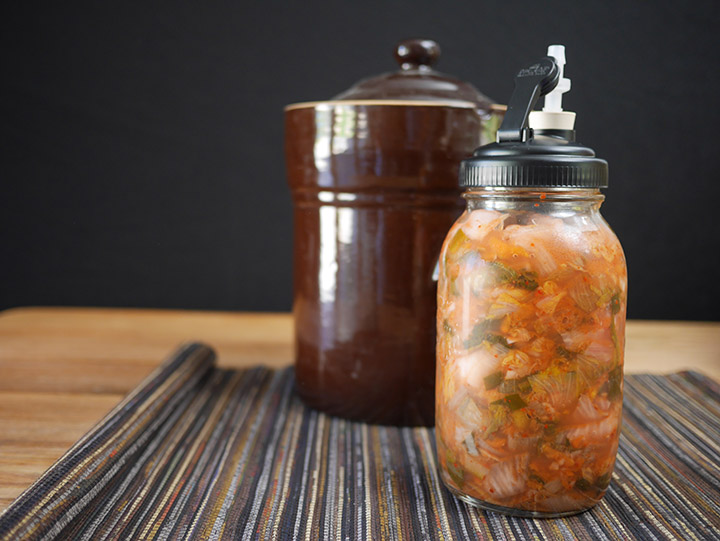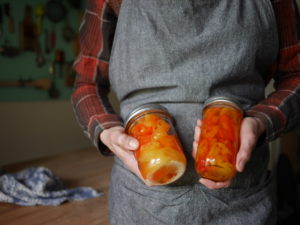
This magical “soul food” of Korea is popular worldwide and often appears on “super food” lists for its long list of health benefits. Let’s start by answering the question, what is kimchi?
Kimchi is the name for any vegetable that is lacto-fermented in Korea’s rich pickling tradition—essentially it means fermented vegetable side dish, or pickle. That said kimchi is beyond just word for pickle. These dishes are a great source of national pride. There are hundreds of known varieties varying from season to season, region to regions, and family-to-family. Most often it is a combination of pepper, garlic, and ginger (frequently radishes are also on this list) that gives kimchi its distinctive (delicious!) flavor.
Contrary to popular belief kimchi doesn’t have to be blazing hot, in fact a good kimchi has a balanced flavor where the ingredients work in harmony—not too salty, too garlicky, too gingery, or too spicy instead it will have a pleasant tangy flavor. You can make and enjoy kimchi whether you like it fiery or just mildly piquant.
Kimchi’s health benefits are numerous. Here is a short list. As a live fermented food, kimchi contains digestive enzymes and probiotics, these promote a healthy gut. The fiber and compounds in the vegetables themselves also give your gut prebiotics (the food that your good bacteria need to thrive), along with antioxidants and a wide range of vitamins and minerals. Eating kimchi regularly can also help regulate cholesterol and glucose tolerance, boost your immune system, and more.
As mentioned, kimchi can be made in many different ways and can be adjusted to be pleasing to your taste buds. This recipe is for basic Baechu kimchi (the Napa cabbage kimchi we all automatically think of). Kimchi involves a water brining step but this water isn’t added to the final ferment. You’ll notice the salt ratio is stronger but don’t be concerned because some of it starts the fermentation with an osmosis process most gets thrown out.

Traditional kimchis often use fish sauce, fermented shrimp, anchovies or other seafood to give it not only flavor but a dose of amino acids produced by the fermentation. We wanted to make a traditional style recipe but wanted to put our own spin on the seafood flavor. This kimchi has a slight smoky flavor and a sublime hint of shrimp. We experimented with a number of bases for the paste and loved this one made a shrimp broth with Japanese Bonito shavings. For a vegetarian or vegan kimchi use coconut aminos for extra umami, or water.
PrintKimchi (Baechu Kimchi)
- Yield: 1/2 gallon 1x
Ingredients
- 1 head Napa Cabbage (about 3 pounds), cut in half lengthwise
Soaking Brine
- 1/2 cup salt
- 2 quarts unchlorinated water
Kimchi Mixture
- 2 cups water
- 1 package shaved shrimp “Bonito Flakes” (available at an Asian market) or, 4 tablespoons coconut aminos with 3/4 water (vegan), or water
- 2 1/2 tablespoons sweet rice flour
- 3/4 cup gochugaru powder (Korean pepper flakes), or red pepper flakes (these will be hotter) to taste
- 1 teaspoon pepper flakes
- 1 carrot, grated
- 1 bunch scallions, cut into 1/2 inch sections
- 1/2 medium to large turnip or daikon, grated
- 1 head garlic, cloves peeled and grated
- 2 tablespoons fresh ginger, grated
Instructions
- In a crock or a large bowl, combine the brine ingredients and stir to dissolve. Rinse the cabbage in cold water then immerse in the brine solution. Use a plate as a weight to keep the cabbage submerged. Set aside, at room temperature for 6–8 hours.
- Using a colander set over a large bowl, drain the cabbage reserving the liquid. Chop the cabbage crosswise in ½ to 1 inch pieces and put in large bowl.
- Bring the two cups of water to a boil and drop in bonito flakes and soak according to package instructions.
- Meanwhile prepare the other vegetables and add to the cabbage bowl.
- Once this broth is ready strain out the flakes and put back in the saucepan (or the combined coconut aminos and water), whisk in the rice flour, and bring to a boil whisking occasionally as to thicken evenly. When the texture is like smooth gravy take off of the heat and stir in the Korean pepper flakes. When cool mix this into the veggies and cabbage.
- Follow the instructions for the type of fermentation vessel you are using. Traditionally kimchi is fermented in stoneware pots called onggi you can get the same results from a water-sealed fermenting crock, a straight-sided crock with weight stones or in a small jar-sized kit which can be less daunting if you are learning to ferment.
- Set aside, somewhere nearby and out of direct sunlight for 10-14 days.
- Check daily to make sure there aren’t CO2 bubbles developing and that the vegetables are submerged; simply press down as needed. If using a plain jar, burp once a day or more often if you see pressure under the lid. Using a utensil, test the kimchi on day 10. You will know it is ready when the flavors have mingled and the pungency is pleasantly fused with acidic tones. The red color will have gotten deeper while the green of the nettle leaf turns a translucent brown khaki green color. You can let this sit another week in the refrigerator with the lid on to allow the flavors to continue to develop. This will store in the refrigerator for 8-12 months
Notes
Recipe adapted from Fiery Ferments.
- Author: Kirsten K. Shockey
Keywords: Kimchi, baechu kimchi, fermenting
*****

Kirsten K. Shockey is the co-author, along with Christopher Shockey, of the bestselling book Fermented Vegetables: Creative Recipes for Fermenting 64 Vegetables and Herbs! and Fiery Ferments. They are passionate about teaching the art of fermentation through classes and workshops. To learn more about Kirsten and Christopher, visit their website ferment.works.

































